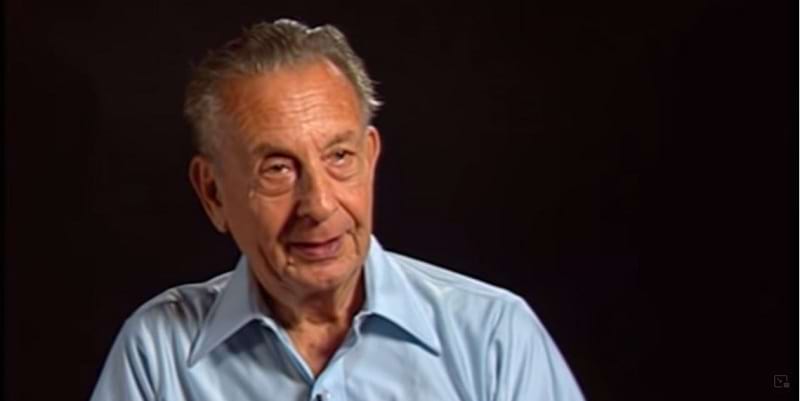George Gerbner biography and books

George Gerbner (8 August 1919 – 24 December 2005) was a professor of communications and the creator of the cultivation theory. This theory states that stories told by a culture determine the behaviour and values of individuals. George Gerbner worked for, among others, the Temple University, the University of Pennsylvania and Villanova University.
Biography of George Gerbner
Early years
George Gerbner was born in Budapest, Hungary, in 1919. He became interested in folklore from a young age and was an excellent poet. In 1938 he started studying at the University of Budapest after winning the first prize in a competition for Hungarian literature.
Military service
Because he wanted to escape mandatory military service, George Gerbner fled to Paris in 1939. He then tried to get a visa for the United States because his half-brother Laszlo Benedek lived there, but it was denied.
Therefore Gerbner travelled to Cuba, via Mexico, where a consultant allowed him to travel to New Orleans from Havana. He was taken in by his half-brother’s friends.
Student life
Having arrived in New Orleans, he hitchhiked to California. He enrolled at the University of California, where he would complete a degree in psychology and sociology. However, Gerbner was not yet finished with university, and in 1942 he received his degree in journalism. Afterwards, he worked as a copy boy, reporter, copy editor, daily columnist and financial editor.
He was previously officially known as an enemy alien but the law was relaxed in 1942 and he was allowed to enlist as a soldier in the American army. George Gerbner was trained to be a paratrooper, then transferred to the Office of Strategic Command and eventually ended up in Italy.
After the defeat of Germany, he was sent to Austria where he investigated Hungarian soldiers’ mass camps. George assisted in the arrest of Dome Sztojay, Hungary’s pro-Nazi prime minister, and returned him to Hungary. Whilst he was stationed in Hungary, he met actress Ilona Kutas. The couple married in 1946.
Career and work of George Gerbner
He returned to Los Angeles and started volunteering with the Independent Progressive Party as a newspaper editor. His activism was noticed by the California House Un-American Committee. Shortly after, George Gerbner was accepted to the John Muir College, now the Pasadena City College, as a journalism lecturer.
To earn his qualifications, he enrolled in a course at California University’s School of Education. He obtained his master’s degree in 1951 with his thesis ‘television and education’. He also obtained a Ph.D. in the audiovisual department with a dissertation titled ‘towards a general theory of communication’.
Cultivation theory and the role of George Gerbner
For his dissertation, he developed the violence profile for television during that time. This method was created as part of the Cultural Indicators Project, which includes a database with more than three thousand television programs. This database helped them provide a consistent monitoring of violence in broadcasts.
George Gerbner regularly testified before Congress in the United States and used these violence profiles to provide evidence that the amount of violence on television changed very little from one season to the next. He also noted that television violence changed the general public’s perceptions of violence and made them more anxious. He referred to this phenomenon as the ‘mean world’ syndrome.
This research would later form the basis for George Gerbner ‘s cultivation theory. The main lesson that can be learned from the cultivation theory is that the more time people spend living ‘life’ in the television world watching a screen, the more likely they are to believe that social reality corresponds to that of the television world.
He then joined the faculty of the Institute for Communications Research at the University of Illinois in Urbana in 1956. In 1964, George Gerbner became a professor of communications and also the dean of the Annenberg School for Communication at the University of Pennsylvania. he quit his job as dean in 1989 but kept on teaching until 1994.
Illness and death
In 2005, George Gerbner was diagnosed with cancer. He died the same year in his apartment in Center City. He had 2 children and 5 grandchildren. After his death, between 2010 and 2014, a conference on communication, conflict and aggression was held in his honour. The conference was organised by Dr. Jolán Róka and Dr. Rebecca M. Chory.
Famous quotes
- You know, who tells the stories of a culture really governs human behavior. It used to be the parent, the school, the church, the community. Now it’s a handful of global conglomerates that have nothing to tell, but a great deal to sell.
- Fearful people are more dependent, more easily manipulated and controlled, more susceptible to deceptively simple, strong, tough measures and hard-line postures. … They may accept and even welcome repression if it promises to relieve their insecurities.
- If you can write a nation’s stories, you needn’t worry about who makes its laws. Today, television tells most of the stories to most of the people most of the time.
- The product is the delivery of the largest number of people at the least cost.
- On prime time entertainment television, scientists are most at risk. Ten percent of scientists featured in prime-time entertainment programming get killed, and five percent kill someone. No other occupational group is more likely to kill or be killed.
Books and publications by George Gerbner
- 2018. Persian Gulf war, the movie. In Triumph of the Image (pp. 243-265). Routledge.
- 2017. Living with television: The violence profile. In The Fear of Crime (pp. 169-195). Routledge.
- 2011. Mass media discourse: Message system analysis as a component of cultural indicators. In Discourse and Communication (pp. 13-25). de Gruyter.
- 2004. Mass communication and American social thought: Key texts, 1919-1968. Rowman & Littlefield Publishers.
- 2002. Growing up with television: Cultivation processes. Media effects: Advances in theory and research, 2(1), 43-67.
- 1998. Cultivation analysis: An overview. Mass communication and society, 1(3-4), 175-194.
- 1995. Standpoint: Violence on television: The cultural indicators project.
- 1994. Growing up with television: The cultivation perspective.
- 1993. The global media debate: Its rise, fall and renewal. ABC-CLIO.
- 1987. Television: How it affects public conceptions. Issues in Science and Technology, 3(3), 109-115.
- 1986. Living with television: The dynamics of the cultivation process. Perspectives on media effects, 17-40.
- 1984. Political correlates of television viewing. Public Opinion Quarterly, 48(1B), 283-300.
- 1982. Charting the mainstream: Television’s contributions to political orientations. Journal of communication, 32(2), 100-127.
- 1982. Programming health portrayals: What viewers see, say, and do. Television and behavior: Ten years of scientific progress and implications for the eighties, 2, 291-307.
- 1981. The violent face of television and its lessons. Children and the faces of television: Teaching, violence, selling, 149-162.
- 1981. A curious journey into the scary world of Paul Hirsch. Communication Research, 8(1), 39-72.
- 1981. Scientists on the TV screen. Society, 18(4), 41-44.
- 1981. Health and medicine on television. New England Journal of Medicine, 305(15), 901-904.
- 1980. Television violence, victimization, and power. American Behavioral Scientist, 23(5), 705-716.
- 1980. The “mainstreaming” of America: violence profile number 11. Journal of communication, 30(3), 10-29.
- 1980. Aging with television: images on television drama and conceptions of social reality. Journal of communication, 30(1), 37-47.
- 1979. Women and minorities in television drama, 1969-1978.
- 1977. TV violence profile no. 8: The highlights. Journal of Communication, 27(2), 171-180.
- 1977. The many worlds of the world’s press. Journal of communication, 27(1), 52-66.
- 1972. Communication and social environment. Scientific American, 227(3), 152-162.
- 1972. Violence in television drama: Trends and symbolic functions. Television and social behavior, 1, 28-187.
- 1970. Cultural indicators: The case of violence in television drama. The Annals of the American Academy of Political and Social Science, 388(1), 69-81.
- 1969. Toward “cultural indicators”: The analysis of mass mediated public message systems. AV communication review, 17(2), 137-148.
- 1969. Analysis of communication content.
- 1966. On defining communication: still another view. Journal of Communication.
- 1965. Institutional pressures upon mass communicators. The Sociological Review, 13(1_suppl), 205-248.
- 1964. Ideological perspectives and political tendencies in news reporting. Journalism Quarterly, 41(4), 495-516.
- 1958. On content analysis and critical research in mass communication. Audiovisual communication review, 6(3), 85-108.
- 1956. Toward a general model of communication. Audiovisual communication review, 4(3), 171-199.
How to cite this article:
Janse, B. (2021). George Gerbner. Retrieved [insert date] from Toolshero: https://www.toolshero.com/toolsheroes/george-gerbner/
Original publication date: 07/07/2021 | Last update: 05/16/2023
Add a link to this page on your website:
<a href=”https://www.toolshero.com/toolsheroes/george-gerbner/”>Toolshero: George Gerbner</a>











